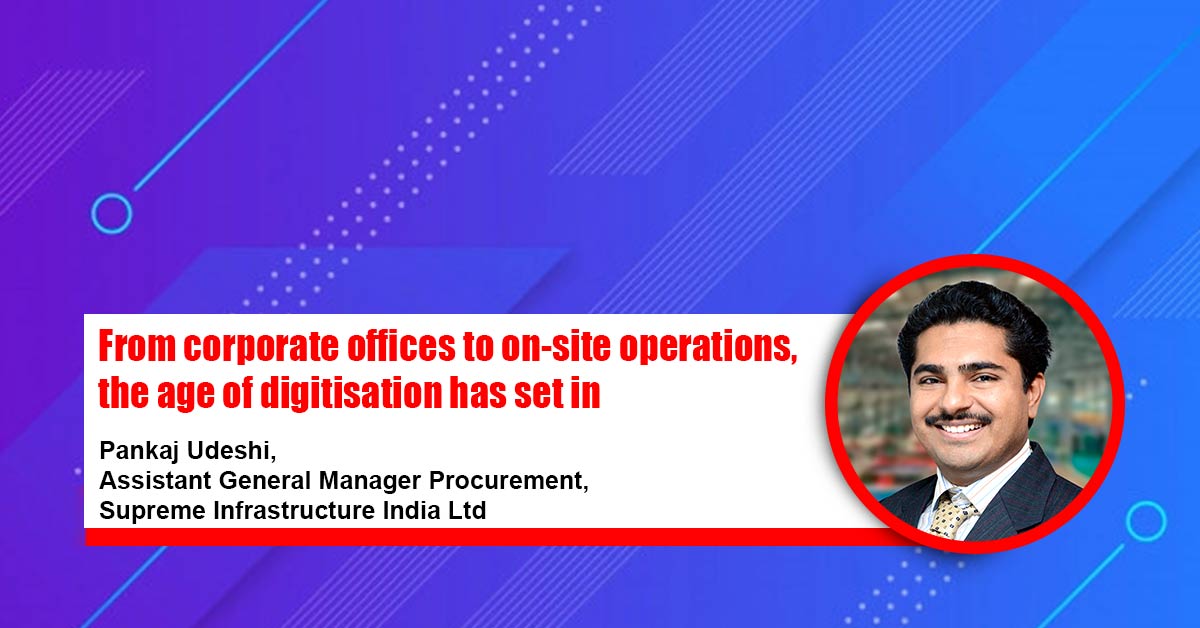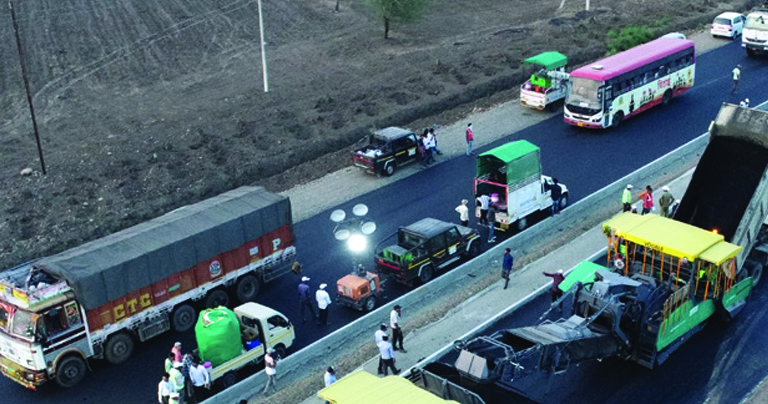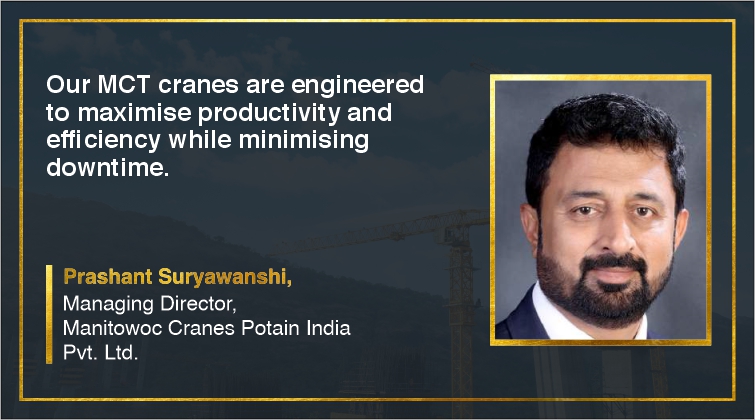From corporate offices to on-site operations, the age of digitisation has set in
By Edit Team | January 9, 2021 11:41 am SHARE

The construction and infrastructure sector is adopting digital practices. DeepTech solutions like Augmented Reality and Virtual Reality (AR/VR) will potentially boom as the most effective and convenient bridge, says Pankaj Udeshi, Assistant General Manager Procurement, Supreme Infrastructure Ltd.
How will the pandemic catalyse the adoption of VR/AR tools, remote monitoring, data analytics to have a real-time view of ongoing projects?
After a major slump in businesses and extended lockdowns across the globe, economies are slowly taking their first step towards returning to work and an integral part of that process would be going “contactless”, as much as is possible and viable. It is here that Deep-Tech solutions like Augmented Reality and Virtual Reality (AR/VR) will potentially boom as the most effective and convenient bridge.
The construction industry is more labour oriented. With operations and development being carried out in harsh and sometimes ecological sensitive areas, well-being and safety of people along with the surrounding ecosystem becomes a paramount priority of all the operators.
Inspections play a crucial role in construction. Before a single piece of foundation is built, the construction site goes through a series of inspections to understand various data points about the soil, drainage, vegetation, surface space and much more. Once the construction process starts, many more inspections are necessary to ensure worker safety, compliance, quality, progress and many other critical data points. In traditional construction, all these inspections are mostly manual, time-consuming and sometimes even dangerous to execute. Imagine the risk of inspecting beams on the 34th floor of a building under construction.
The training process could become highly automated with increased effectiveness with the use of Augmented Reality (AR)/ Virtual Reality (VR) based tools. Using virtual reality, learners can engage in environments that reflect different real-world conditions, even potentially dangerous ones, without being exposed to the actual risk factors. They can safely practice site-specific skills while being monitored and assessed until they have mastered their training. Thus the overall impact of the training could increase manifold. This could be very relevant for scenarios where workers have to work on remote/offshore and hazardous locations. Such training can be imparted through a digital platform, across geographies and at any time to individuals.
The VR-based training replicates critical conditions of the various activities. This facilitates the workers to get accustomed to the situations in advance. The VR platform helps in enhancing the efficiency of training exercises at reduced training cost.
Drones are now being deployed to expedite these inspections. They can cover a wide area in short time spans. They have very advanced lenses that can capture detailed, close up images, and send data in real-time to computer systems and intelligent machines which can react in real-time to the data received. There are many advantages to collecting digital data from drones. One large benefit is that the data lets builders perform pre-construction simulations, allowing them to test various hypotheses and designs and lower the risk of error before breaking ground for the first time. Another benefit is being able to perform construction tasks remotely and unmanned. 3D printing, or additive manufacturing, is also transforming the way complex structures are being built printing concrete structures at high speed.
Contracting firms worldwide rely on employees who are not chained to desks or main offices and can benefit from custom mobile solutions. General labourers, construction workers, foremen, and supervisors alike can streamline business processes and experience the benefits of real-time operability provided by mobile solutions.
General contractors are constantly required to undergo site inspections. Foregoing paper forms and switching to mobile phones or tablets can greatly improve efficiency and accuracy when collecting on-site data. With a mobile device at his/her disposal, the construction worker can log findings from a daily task, such as a site inspection, and deliver information on-site or offsite to a remote office location.
Mobile solutions improving business processes for the construction industry, general contractors are faced with the possibility of an emergency evacuation of the construction site or accidental injury that would require instantaneous communication. With GPS-enabled smartphones and tablets that allow for geolocation, supervisors and managers can address issues more quickly—not only saving time and money but also lives.
On the corporate side, meetings and conferences have anyway started happening online and it is only a matter of time that all major organizations will shift to VR meetings and seminars. We are already seeing major blue-chips in India adopt and operationalize VR platforms that replicate real-life corporate scenarios with or without expensive VR-headsets, thereby enhancing much needed access.
If current trends are anything to go by and as businesses realize the long term impact of AR/VR on profit and health, it is sure to become the next big rage after smart phones hit the world.
What kind of transformation do you expect to see in the pattern of procurement in the post-Covid era for equipment and structure solutions for projects?
The construction industry was already starting to experience an unprecedented rate of disruption before the Covid-19 pandemic. In the coming years, fundamental change is likely to be catalyzed by changes in market characteristics, such as scarcity of skilled labour, persistent cost pressure from infrastructure and affordable housing, stricter regulations on work-site sustainability and safety, and evolving sophistication and needs of customers and owners. Emerging disruptions, including industrialisation and new materials, the digitalisation of products and processes, and new players, will shape future dynamics in the industry.
Many executives are wrestling with the pandemic’s economic disorder, the shifts in demand it entails, and operating restrictions and longer-term safe working procedures. However, it is also critical for executives to lift their view to what the future will hold in terms of changes to business models and industry dynamics.
In a post-Covid-19 world, supply chain stress tests will become a new norm. The distributed global business model, optimized for minimum cost, is finished. Tomorrow’s model demands new priorities in optimization. Covid-19 has revealed the weaknesses of a globalized manufacturing system and to respond we need to fundamentally rethink supply chains. Our goals in the medium term should be making them more regional, modifying the supply chain as a key business driver and putting back the human asset as the most important factor for an agile business to succeed.
Construction and infrastructure sector are learning to adopt the use of digital technologies to adhere to social distancing regulations. These digital technologies are completely transforming construction businesses’ operations.
A digital collaborative platform supports a many-to-many relationship by connecting all supply chain participants involved in the construction project.
Over the next two decades, manufacturers will transition from producing traditional heavy machinery and tools used in the construction process to highly automated, connected products used in the ecosystem. The new equipment will be integrated with robotics that could be used in the ecosystem’s manufacturing processes—for example, in plants for building materials, components, and buildings. Rather than simply selling products, manufacturers will offer services that are completed with their products. This will increase the value-added of machinery, and increasing automation will support greater volume. Also, demand for machinery used in offsite fabrication is expected to rise. In turn, improved efficiency and reduced time requirements for on-site work are expected to have a negative impact on the volume of machines sold.
The equipment rental industry is passing through a difficult phase. The construction sector is not only facing an acute shortage of skilled manpower but the labour cost has also gone up. The work progress is slow-moving and has not started at many sites properly due to Covid-19 pandemic. Shortage of liquidity and payments are still jammed.
As new technologies, especially telematics and artificial intelligence are going to transform the equipment industry, and maintaining a fleet of such technologically advanced equipment will become necessary. Artificial Intelligence will make tracking and monitoring of equipment quite easy and reduce the cost of operations.
Cookie Consent
We use cookies to personalize your experience. By continuing to visit this website you agree to our Terms & Conditions, Privacy Policy and Cookie Policy.



































-20240213125207.png)

























